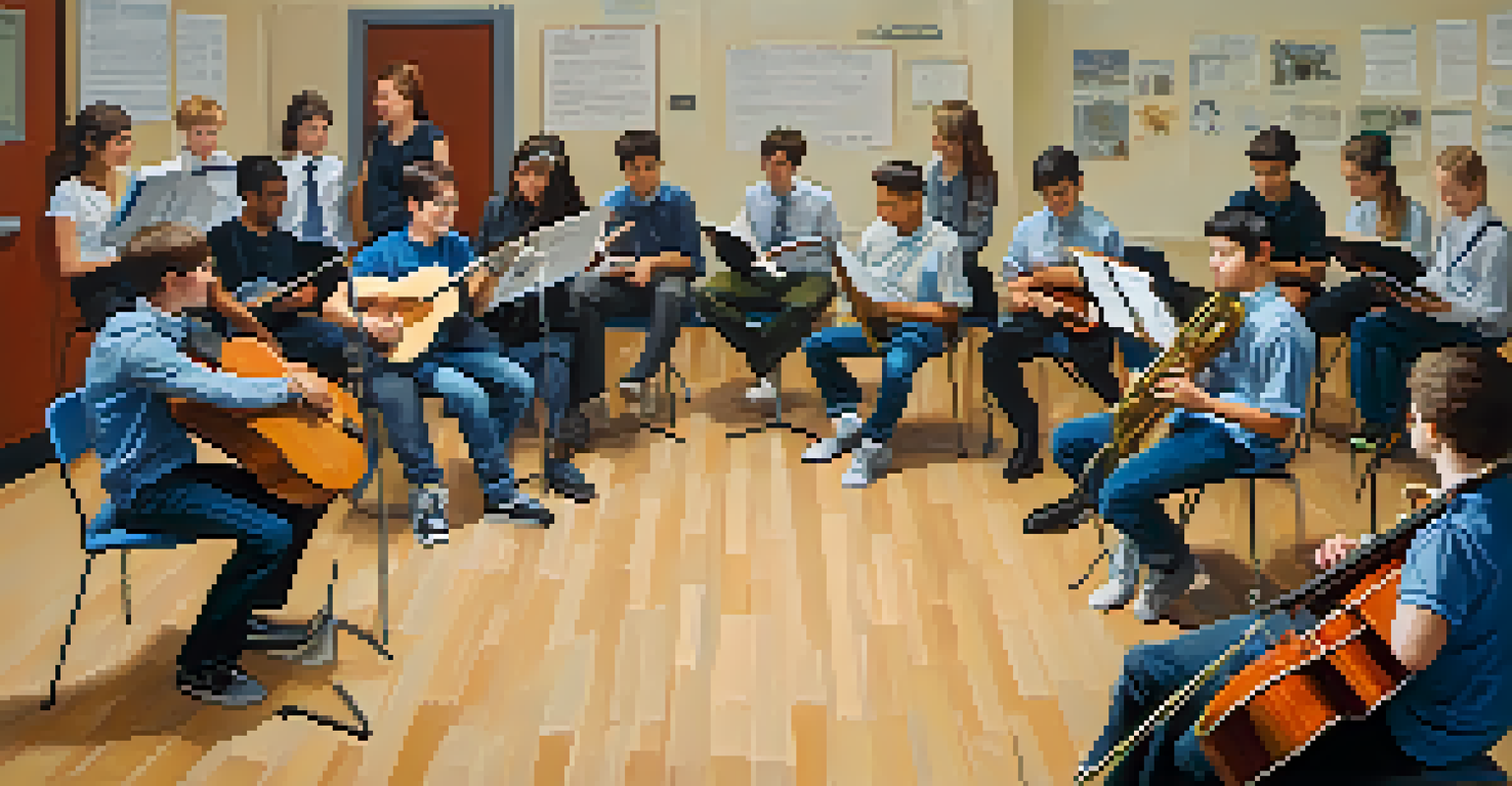Evaluating the Effectiveness of Music Education Assessments

Understanding the Purpose of Music Education Assessments
Music education assessments serve to gauge students' understanding and skills in music. They help educators identify areas where students excel and where they may need extra help. These assessments can take many forms, including performance evaluations, written tests, or project-based assignments, each tailored to different learning outcomes.
Music education is essential in developing not just musical skills, but also critical thinking and creativity.
The ultimate goal is to enhance the learning process, ensuring that students not only grasp musical concepts but also apply them creatively. By understanding the purpose behind these assessments, educators can design evaluations that truly reflect students' musical abilities and interests. This clarity also helps in communicating expectations to students and parents alike.
Moreover, effective assessments can motivate students, encouraging a deeper engagement with music. When students see a direct correlation between their efforts and the feedback they receive, it fosters a sense of accomplishment and sparks a desire to improve further.
Different Types of Music Education Assessments
There are several types of assessments in music education, each serving a distinct purpose. Formative assessments, like quizzes or informal performances, provide ongoing feedback throughout the learning process. Meanwhile, summative assessments, such as end-of-term concerts or exams, evaluate what students have learned over a specific period.

Performance assessments are particularly popular in music, allowing students to showcase their skills in real-time. These can include solo performances, ensemble work, or even composition presentations. Such assessments not only evaluate technical skills but also musical expression and creativity.
Purpose of Music Assessments
Music education assessments gauge students' understanding and skills, helping educators provide targeted support.
Moreover, self-assessments encourage students to reflect on their own progress and set personal goals. This type of assessment fosters a growth mindset, encouraging students to take ownership of their learning journey while providing valuable insights for educators to tailor their teaching strategies.
Aligning Assessments with Learning Objectives
For music assessments to be effective, they must align with clear learning objectives. This means that every assessment should serve a purpose, measuring specific skills or knowledge that students are expected to acquire. When assessments are directly tied to these objectives, they provide a more accurate picture of a student's abilities.
The best way to predict the future is to create it, and music education assessments help shape students' musical journeys.
For example, if a learning objective is to understand rhythm patterns, an assessment focusing on rhythm performance would be appropriate. This alignment ensures that both students and teachers know what is being measured and why, making the process more transparent and focused.
Additionally, when assessments are aligned with learning objectives, they can help educators identify curriculum gaps. If many students struggle with a particular assessment, it may indicate that the teaching methods or materials need to be revisited, allowing for timely adjustments that can enhance learning outcomes.
Incorporating Technology in Music Assessments
Technology is reshaping the landscape of music education assessments in exciting ways. Digital tools can facilitate both the assessment process and feedback collection, making it easier for educators to evaluate student performance. For instance, video recordings allow students to review their performances, enabling self-assessment and reflection.
Moreover, online platforms can host interactive assessments, where students engage with music theory through games and quizzes. These platforms often provide immediate feedback, helping students to identify strengths and weaknesses quickly. Such immediacy can enhance learning, as students can adjust their practice based on instant results.
Types of Music Assessments
Different assessment types, including formative and summative, serve unique roles in evaluating student progress.
However, it's essential to balance technology with traditional methods. While tech offers innovative ways to assess learning, it shouldn't replace the personal touch of live performances or in-person evaluations, which can provide deeper insights into a student's musicality and emotional connection to the music.
The Role of Feedback in Music Education Assessments
Feedback plays a critical role in the effectiveness of music education assessments. Constructive feedback helps students understand their strengths and areas for improvement, guiding their practice and growth. It's not just about grades; it's about creating a dialogue that fosters learning.
Effective feedback should be specific, timely, and focused on both the technical and expressive elements of music. For example, instead of just saying a performance was 'good' or 'bad,' feedback could highlight what was done well, such as dynamics or phrasing, and what could be improved, like timing or articulation.
Additionally, encouraging peer feedback can enhance the learning experience. When students evaluate each other’s performances, they develop critical listening skills and gain diverse perspectives. This collaborative approach not only reinforces their understanding of music but also builds a supportive learning community.
Challenges in Evaluating Music Education Assessments
Evaluating music education assessments comes with its own set of challenges. One of the main hurdles is ensuring objectivity, as music is often subjective and personal. What resonates with one person may not have the same effect on another, making it tricky to benchmark performances.
Additionally, the diversity of musical styles and genres can complicate evaluations. A classical piece may require different skills than a jazz improvisation, yet both are valid expressions of musical talent. Educators must be careful to create a balanced assessment framework that respects various musical backgrounds and preferences.
Importance of Feedback
Constructive feedback is essential for guiding student growth and enhancing their musical abilities.
Finally, time constraints can be a significant barrier. Assessing performances and providing meaningful feedback can be time-consuming, especially in larger classes. Finding efficient methods to evaluate and give feedback without sacrificing quality is essential for effective music education.
Best Practices for Effective Music Education Assessments
To create effective music education assessments, educators should consider incorporating a variety of assessment types. A mix of formative and summative assessments can provide a comprehensive view of student progress. Additionally, utilizing peer assessments and self-reflections can empower students to take an active role in their learning.
Establishing clear criteria for assessments is also crucial. Rubrics that outline specific expectations can guide students in their preparation and help educators maintain consistency in grading. This transparency fosters a sense of fairness and clarity, helping students understand how they can achieve their goals.

Lastly, ongoing professional development for educators is essential. Staying updated with the latest assessment strategies and technologies can enhance the quality of evaluations. By continually refining their approach, teachers can ensure their assessments remain relevant and effective in promoting student growth in music.